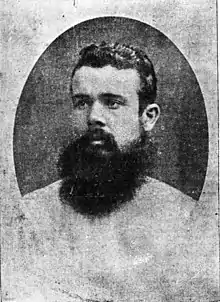Christie Palmerston
Cristofero Palmerston Carandini or Christopher "Christie" Palmerston (1850 – 15 January 1897) was an Australian explorer and prospector in North Queensland. He led several expeditions during the last quarter of the 19th century including the discovery of a route along the Mowbray River, which eventually led to the founding of Port Douglas.[2]
Christie Palmerston | |
|---|---|
 | |
| Born | Cristofero Palmerston Carandini[1] 1850 |
| Died | January 15, 1897 |
| Occupation | Prospector and explorer of North Queensland |
| Spouse(s) | Teresa Rooney |
| Children | 1 daughter |
Early life
It has been claimed that Palmerston was the natural son of Lord Palmerston. However, Palmerston was born in Melbourne to Casino Jerome Carandini, the 10th Marquis of Sarzano and Marie Burgess, an English-born opera singer. Palmerston was baptised Cristofero Palmerston Carandini.[2][3] This is the name he gives on his marriage registration in 1886, when he listed his father as Casino Carandini.[4] His elder brother Frank succeeded to the marquessate upon their father's death in 1870,[5] and his sister Isabella Sara married in 1886, Sir Norman Montgomery Abercrombie Campbell, 10th Baronet.[6]
Employment and conviction in central Queensland
In 1868 Christopher Palmerston, in a departure from the theatrical heritage of his family, was employed as a stockman on the Willangi cattle station near St Lawrence in the Broadsound area of central coastal Queensland. The station was run by brothers William and Mark Christian who were powerful squatters in the region. While droving cattle to Rockhampton in early 1869, Palmerston rode off on one of his employer's horses and sold the saddle to a stable owner. He was arrested for horse stealing and later convicted. Palmerston appealed the decision but it was dismissed and he was sentenced to two years in a Brisbane prison.[7][8]
Prospecting and early expeditions
Palmerston then worked in the Palmer River gold rush of 1872-1874. However, it was not until around 1876 during the Hodgkinson River gold Rush that Palmerston began to be known as a pathfinder.[2]
As trade increased from Hodgkinson, Cooktown merchants began to worry that a new port at Cairns would take over the majority of the trade. As a result, in 1877 the merchants backed Palmerston to cut a track from the goldfields to a new port at Island Point. As Palmerston became more well known as a path cutter, he embarked on more explorations, including his notable discovery of a route along the Mowbray River, which contributed to the founding of Port Douglas.[2]
During the 1880s, large parts of coastal far North Queensland were still covered in dense rainforest.[9] Palmerston boasted of shooting a large number of Aboriginals in Mamu territory.
In 1880, Palmerston was part of a private expedition led by James Venture Mulligan to search for gold at the heads of the King and Lukin rivers in northern Queensland. On the King River, Mulligan wrote about how Palmerston shot two Aboriginal men and returned to camp with a stolen "little blackboy". At night, they handcuffed the child to Pompey, Palmerston's other "boy", to prevent him from escaping. The expedition failed to find any significant signs of gold deposits.[10]
Later life and death
Palmerston settled down in Townsville and married Teresa Rooney at St Joseph's Church on 6 December 1886; they had one daughter. Palmerston moved to Borneo and then Malaya where he contracted fever in the jungle and died at Kuala Pilah on 15 January 1897.[2]
References
- Far North Queensland, Australia, Pioneers & Settlers Registers, 1825 -1920
- Bolton, G.C. "Palmerston, Christie (1850-1897)". Australian Dictionary of Biography. Melbourne University Press. ISSN 1833-7538. Retrieved 31 October 2011 – via National Centre of Biography, Australian National University.
- Woolston, F.P.; Colliver, F.S. (1967). "Christie Palmerston — A North Queensland Pioneer, Prospector and Explorer". "Queensland Heritage". 1 (7): 30–34. Retrieved 31 October 2011.
- Australia, Marriage Index, 1788-1950
- de La Caillemotte de Massue de Ruvignés, 9th Marquis de Massue de Ruvignés and Raineval, Melville Amadeus Henry Douglas Heddle (1914). The Titled Nobility of Europe: An International Peerage, Or "Who's Who", of the Sovereigns, Princes and Nobles of Europe. Harrison & Sons. p. 1311. Retrieved 26 July 2018.
- Dod, Charles Roger; Dod, Robert Phipps (1904). Dod's Peerage, Baronetage and Knightage of Great Britain and Ireland, Including All the Titled Classes. p. 219. Retrieved 26 July 2018.
- "ROCKHAMPTON DISTRICT COURT". Rockhampton Bulletin And Central Queensland Advertiser (1036). Queensland, Australia. 9 March 1869. p. 2. Retrieved 27 September 2018 – via National Library of Australia.
- "SUPREME COURT". The Brisbane Courier. XXIII (3, 642). Queensland, Australia. 5 June 1869. p. 5. Retrieved 27 September 2018 – via National Library of Australia.
- Farnfield, Jean (1978). "Legend of North Queensland — Christie Palmerston (1851-1897)". Lectures on North Queensland: Third series. Townsville, QLD: James Cook University, History Department. pp. 69–84. ISBN 978-0-909714-94-9.
- "SKETCHER". The Queenslander (2017). Queensland, Australia. 5 November 1904. p. 8. Retrieved 24 September 2018 – via National Library of Australia.
External links
| Wikimedia Commons has media related to Christie_Palmerston. |
For another view of Christie Palmerston: